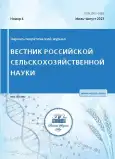Usage of different planting schemes for mini-tubers potato growing under North Ossetia-Alania republic conditions
- Authors: Oves E.V1, Kardanova I.S1, Etdzaeva K.T1, Gaitova N.A1
-
Affiliations:
- Russian Potato Research Centre
- Issue: No 4 (2023)
- Pages: 44-49
- Section: Articles
- URL: https://journals.rcsi.science/2500-2082/article/view/141507
- DOI: https://doi.org/10.31857/2500-2082/2023/4/44-49
- EDN: https://elibrary.ru/DMPPMT
- ID: 141507
Cite item
Full Text
Abstract
About the authors
E. V Oves
Russian Potato Research Centre
Email: oveselena@mail.ru
I. S Kardanova
Russian Potato Research Centre
K. T Etdzaeva
Russian Potato Research Centre
N. A Gaitova
Russian Potato Research Centre
References
- Молявко А.А. Марухленко А.В., Борисова Н.П. Урожайность и выход стандартной фракции мини-клубней картофеля при внесении хелатных удобрений на питательном грунте Агробалт-Н под тоннельными укрытиями // Аграрная наука. 2022. № 6. С. 86-91.
- Хутинаев О.С., Старовойтов В.И., Старовойтова О.А. и др. Выращивание мини-клубней картофеля и топинамбура в условиях водно-воздушной культуры с использованием искусственного освещения // Вестник Московского государственного агроинженерного университета имени В.П. Горячкина. 2018. №4(86). С. 7-14.
- Anisimov B., Simakov E., Mityushkin A. et al. Potato Seed Production in Russia // Potato Journal. 2018. Vol. 45. No.2. P. 152-158.
- Awati R., Bhattacharya A., Char B. Rapid Multiplication Technique for Production of High -Quality Seed Potato (Solanum tuberosum L.) Tubers // Journal of Applied Biology & Biotechnology. 2019. Vol. 7(01), PP. 001-005/ doi: 10.7324/JABB.2019.70101
- Dimante I., Gaile Z. The effect of planting density on potato (Solanum tuberosum L.) Minituber number, weight and multiplication rate. Research for rural // Research for rural development 2016. Vol. 1. Р. 27-33.
- Dimante I., Mežaka I., Gaile Z. The effect of minituber weight on their field performance under a Northern European environment. Agronomy Research. 2019.17(2): 396-407. doi: 10.15159/AR.19.063
- Fouad M., Genesia F., El-Hamed A., Basma A. El-Safty Influence of Plant Density and Genotype on Potato Minituber Production from Microshoots and Microtubers // International Journal on Environmental Sciences. 2018. Vol. 17. Iss.1. P. 77 - 84.
- Jin H., Liu J., Song B, Xie C. Impact of Plant Density on the Formation of Potato Mimitubers Derived from Microtubers and Tip-Cuttings in Plastic Houses // Journal of Integrative Agriculture. 2013. Vol. 12(6): 1008-1017. doi: 10.1016/S2095-3119(13)60321-4.
- Ozkaynak E. Tuber size effects on yield and number of potato minitubers of commercial varieties in a greenhouse production system // Turkish Journal of Field Crops. 2021. Vol. 26, Issue: 1. PP: 122 - 127. doi: 10.17557/tjfc.950280.
- Ozturk G., Yildirim Z. Tuber characteristics of disease free meristem clones of some potato genotypes // Turkish Journal of Field Crops. 2020. 25: 174-180.
- Sadawarti M.J., Samadhiya R.K., Kumar V. et al. Hi-tech planting materials performance under in vivo conditions for potato breeder seed production // International Journal of Chemical Studies. 2018. 6(3):817-822.
- Zeyruk V.N., Vasilieva S.V., Belov G.L. et al А boost to integrated management of certain potato diseases using metal nanoparticles // Potato Research. 2022. V. 65.2. PP: 273-288.
Supplementary files










